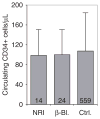Hematopoietic stem cell mobilization: updated conceptual renditions
- PMID: 22951944
- PMCID: PMC3676423
- DOI: 10.1038/leu.2012.254
Hematopoietic stem cell mobilization: updated conceptual renditions
Abstract
Despite its specific clinical relevance, the field of hematopoietic stem cell mobilization has received broad attention, owing mainly to the belief that pharmacologic stem cell mobilization might provide clues as to how stem cells are retained in their natural environment, the bone marrow 'niche'. Inherent to this knowledge is also the desire to optimally engineer stem cells to interact with their target niche (such as after transplantation), or to lure malignant stem cells out of their protective niches (in order to kill them), and in general to decipher the niche's structural components and its organization. Whereas, with the exception of the recent addition of CXCR4 antagonists to the armamentarium for mobilization of patients refractory to granulocyte colony-stimulating factor alone, clinical stem cell mobilization has not changed significantly over the last decade or so, much effort has been made trying to explain the complex mechanism(s) by which hematopoietic stem and progenitor cells leave the marrow. This brief review will report some of the more recent advances about mobilization, with an attempt to reconcile some of the seemingly inconsistent data in mobilization and to interject some commonalities among different mobilization regimes.
Conflict of interest statement
The authors declare no conflict of interest.
Figures


References
Publication types
MeSH terms
Grants and funding
LinkOut - more resources
Full Text Sources
Other Literature Sources

